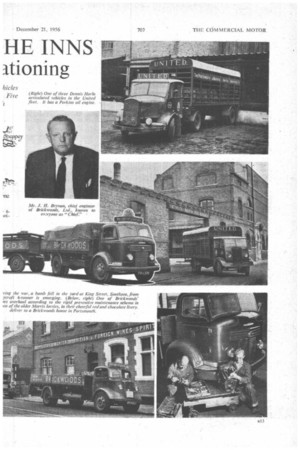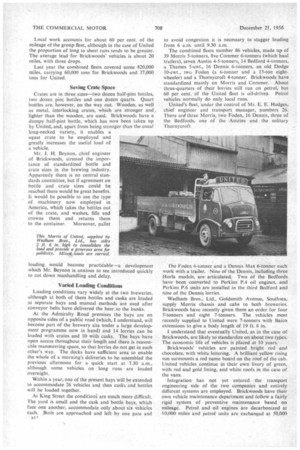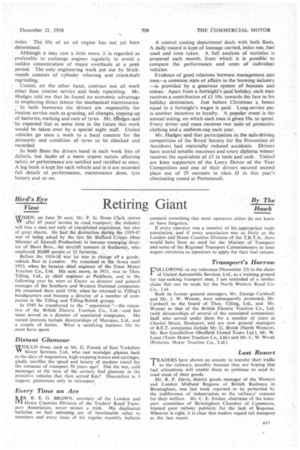STOCKII` HE INNS Despi itioning
Page 46

Page 47

Page 48

Page 49

If you've noticed an error in this article please click here to report it so we can fix it.
AN approach to the integration of their transport fleets has been made through the amalgamation of Brickwoods, Ltd., and Portsmouth and Brighton United Breweries, Ltd. The process is in its early stages, but it will be accelerated by fuel rationing, which will require the utmost co-ordination if supplies are to be maintained to the thousand tied houses, as well as to the many free houses, clubs, messes and so on, now served.
The basic fuel ration will give each company a little over half the normal mileage. Even with a liberal supplementary issue it seems likely that some houses, particularly those in the country, will at times run out of beer.
Fortunately, the mileage normally covered in winter is about 30 per cent lower than in the summer and it may be possible to Scrape through the first four-month rationing period without too much hardship. If rationing continues, serious difficulties will arise. Although
Easter—the first peak of the year next year falls outside the first four months of rationing, stocking-up begins a fortnight before. theholiday and ingenuity will be required to meet the heavy demands on transport.
There is a strict limit to the length of time that beer can be stored. Brickwoods do not like casked ale to remain in a house for more than a week and unless quality is to suffer it will be impossible substantially to increase the size of individual deliveries to compensate for their fewer number. Landlords will probably have to be persuaded to accept less bottled beer, which occupies about 70 per cent, more space in a lorry than casks, and to order more draught ale.
At present, deliveries are in the proportion of approximately 60 per cent bottled beer to 40 per cent. draught. Fortunately for the transport departments, the rise in the consumption of bottled beer seems to have ceased and demands have become stable. Barrels (36 gallons) and kilderkins (18 gallons) are the most popular sizes of cask.
a 1 -" Brickwoods face a double rationing problem. Their boilers are off-fired and supplies of oil fuel have been cut by 10 per cent.
Stocking-up for Christmas began on December 3 and, in happier circumstances, today would have been one of peak pressure. This year,. however, there will be no last-minute rush to deliver late ordersunless customers can supply their own transport.
In the case of the two Portsmouth breweries, the summer peak, wIlieb lasts from -June until midSeptember and reaches a climax just before August Bank Holiday, is slightly higher than that at Christmas. The area that they serve is a favourite holiday centre ind covers about 160 miles of the, south coast and inland to Swindon, about 60 miles to the north-west.
Brickwoods' brewery is at Admiralty Road, Portsmouth, and the United headquarters are at King Street, Southsea. (The old United brewery at Brighton has been converted into a malting.) • From these centres, depots at Southampton, Newport (Isle of Wight), Bournemouth, Hove and Stonehenge are served daily with bulk loads in bottle and cask. Each depot normally has four 5-tonners attached to it.
Houses within a radius of 26 miles.af Portsmouth are supplied direct from the brewery. 'A special delivery is also made to the Isle of Sheppey direct from Portsmouth, a distance of 100 miles as the crow flies. One of United's articulated outfits serves Hove depot, from which the popular resorts of Eastbourne and Hastings, among others, are supplied.
Mixed loads are carried, crates being concentrated at the front of the body, where possible, in the interests of even weight distribution; Brickwoods' country houses receive two deliveries a week and those in Portsmouth three or four.. United's local inns are served twice a week and those at Sleirieer distarice;once.'
Local work accounts for about 60 per cent, of the mileage of the group fleet, although in Ihe case of United the proportion of long to short runs tends to be greater. The average lead for Brickwoods' vehicles is about 20 miles, with three drops.
Last year the combined fleets covered some 820,000 miles, carrying 60,000 tons for Brickwoods and 37,000 tons for United.
Saving Crate Space Crates are in three sizes—two dozen half-pint bottles, two dozen pint bottles and one dozen quarts. Quart bottles are, however, on the way out. Wooden, as well as metal, interlocking crates, which are stronger and fighter than the wooden, are used. Brickwoods have a dumpy half-pint bottle, which has now been taken up by United, and, apart from being stronger than the usual long-necked variety, it enables a squat crate to be employed and greatly increases the useful load of
a vehicle.
Mr. J. H. Beynon, chief engineer
of Brickwoods, stressed the importance of standardized bottle and crate sizes in the brewing industry. Apparently there is no central standards committee, but if agreement on bottle and crate sizes could be reached there would be great benefits. It would be possible to use the type of machinery now employed in America, which takes the bottles out of the crate, and washes, fills and crowns them and returns them to the container. Moreover, pallet loading would become practicable—a development which Mr. Beynon is anxious to see introduced quickly to cut down manhandling and delay.
Varied Loading Conditions
Loading conditions vary widely at the two breweries, although at both of them bottles and casks are loaded at separate bays and manual methods are used after conveyor belts have delivered the beer, to the banks.
At the Admiralty Road premises the bays are on opposite sides of a public road (which, I understand, will become part of the brewery site under a large development programme now in hand) and 14 lorries can be loaded with crates and 10 with casks. The bays have open access throughout their length and there is reasonable manoeuvring space, so that lorries do not get in each other's way. The decks have sufficient area to enable the whole of a morning's deliveries to be assembled the previous afternoon for a quick start at 7.30 a.m.,
although some vehicles on long runs are loaded overnight.
Within a year, one of the present bays will be extended to accommodate 26 vehicles and then casks and bottles will be loaded together.
At King Street the condition i are much more difficult. The yard is small and the cask and bottle bays, which face one another, accommodate only about six vehicles each. Both are approached and left by one gate and to avoid congestion it is necessary to stagger loading from 6 a.m. until 9.30 a.m.
The combined fleets number 86 vehicles, made up of 39 Morris 5-tanners, five Commer 6-tonners (which haul trailers), seven Austin 4-5-tonners, 14 Bedford 4-tonners, a Thames 5-cwt., 16 Dennis 6-tonners, an old Dodge 10-cwt., two Foden (a 6-tonner and a 15-ton eightwheeler) and a Thornycroft 4-tonner. Brickwoods have standardized mainly on Morris and Commer. About three-quarters of their lorries still run on petrol, but 60 per cent, of the United fleet is oil-driven. Petrol vehicles normally do only local runs.
United's fleet, under the control of Mr. E. E. Hodges, chief engineer and transport manager, numbers 26. There ard three Morris, two Foden, 16 Dennis, three of the Bedfords, one of the Austins and the solitary Thorn ycro ft.
ftc Foden 6-tonner and a Dennis Max 6-tormer each work with a trailer. Nine of the Dennis, including three Horla models, are articulated. Two of the Bedfords have been converted to Perkins P.4 oil engines, and Perkins P.6 units are installed in the third Bedford and nine of the Dennis lorries.
Wadham Bros., Ltd., Goldsmith Avenue, Southsea, supply Morris chassis and cabs to both breweries. Brickwoods have recently given them an order for four 5'-tonners and eight 7-tonners. The vehicles most recently supplied to United were 7-tonners with Baico extensions to give a body length of 19 ft. 6 in.
I understand that eventually United, as in the case of Brickwoods, are likely to standardize on about two types. The economic life of vehicles is placed at 10 years.
Brickwoods' vehicles are painted bright red and chocolate, with white lettering. A brilliant yellow rising sun surmounts a red name board on the roof of the cab. United vehicles continue in their own livery of green, with red and gold lining, and white roofs in the case of the vans.
Integration has not yet entered the transport engineering side of the two companies and entirely different systems are employed. Brickwoods have their own vehicle maintenance department and follow a fairly rigid system of preventive maintenance based on mileage. Petrol and oil engines are decarbonized at 10.000 miles and petrol units are exchanged at 50,000 miles. The life of an oil engine has not yet been determined.
Although it may cost a little more, it is regarded as preferable to exchange engines regularly to avoid a sudden concentration of major overhauls at •a peak period. The only engineering work put out by Brickwoods consists of cylinder reboring and crankshaft regrinding.
United, on the other hand, contract out all work other than routine service and body repainting. Mr. Hodges told me that he found no economic advantaga in employing direct labour for mechanical maintenance.
In both breweries the drivers are responsible for routine service such as greasing, oil changes, topping-up of batteries, washing and care of tyres. Mr. godges said he expected that at some time in the future this work would be taken over by a special night staff. United vehicles go once a week to a local concern for the pressures and condition of tyres to be checked and recorded.
In both fleets the drivers hand in each week lists of defects, but faults of a more urgentnature affecting safety or performance are notified and rectified at once. A log book is kept for each vehicle and in it are recorded full details of performance, maintenance done, tyre history and so on. A central costing department deals with both fleets. A daily record is kept of tonnage carried, miles run, fuel used and time taken. A full analysis of statistics is prepared each month, from which it is possible to compare the performance and costs of individual vehicles.
Evidence of good relations between management and men—a common state of affairs in the brewing industry —is provided by a generous system of bonuses and extras. Apart from a fortnight's paid holiday, each man receives-a contribution of fl 10s. towards the fare to his holiday destination. Just before Christmas a bonus equal to a fortnight's wages is paid. Long-service pay is another incentive to loyalty. A popular event is the annual outing, on which each man is given 10s. to spend. Every driver and mate receives two suits of protective clothing and a uniform cap each year.
Mr. Hodges said that participation in the safe-driving competition of the Royal Society for the Prevention of Accidents. had materially reduced accidents. Drivers have scored notable successes and every diploma winner receives the equivalent of £5 in tools and cash. United are keen supporters of the Lorry Driver of the Year Competition and one of their drivers secured second place out of 29 entrants in class D in this year's eliminating round at Portsmouth.




























































































